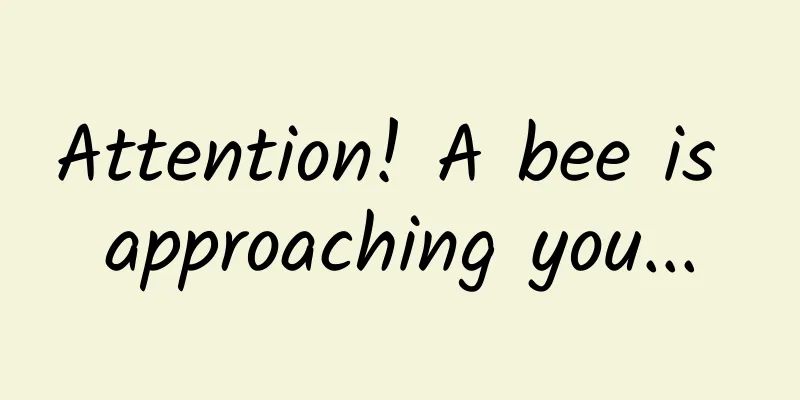Attention! A bee is approaching you...

|
On a lazy afternoon, the visit of a bee by the window may make you perk up! The black and yellow "warning" color triggers our vigilance - bees can be seen everywhere in urban life, some of them are small, some are huge; some collect nectar from flowers, some wave their large jaws to gnaw on tree bark, and some even build their nests in your home. Pictured: A flying yellow-legged hornet As our "wild neighbors", encounters are inevitable. How can we safely establish harmonious neighborhood relations ? It seems unrealistic to make people fall in love with these "dangerous" bees all at once, but we can gradually understand them, reduce our fear of them, and achieve harmonious coexistence. Bee is a general term for hundreds of thousands of species of animals in the order Hymenoptera except ants (bees and ants are close relatives!). There are many species of them, and their lifestyles are also colorful: some are vegetarians, some are carnivorous, some parasitize other insects, and some live in symbiosis with plants... Among them, the most common and familiar to us are the two major families of Apidae and Vespidae. beeThere are about 30,000 species of bees known to humans. There are small bees (pale-veined tunnel bees) and large bees (bumble bees). Among them, the western honey bee and the oriental honey bee are the two species we are most familiar with. The Chinese honey bee is a subspecies of the Oriental honey bee, and a subspecies unique to China. It is mainly distributed in the Yangtze River Basin and mountainous areas of southern China. It is the main pollinator in forest system communities dominated by mixed woods and in traditional agriculture, and produces nectar from a variety of flowers. Chinese honey bee Compared to other bees, honey bees are relatively moderate - they feed on nectar and pollen, and can pollinate flowering plants in the process. Guide to getting along Despite their furry appearance, bees, as members of the bee family, can sting ! Female bees have specialized ovipositors that are retracted into their bodies and used for self-defense when threatened. The bee's stinger has dense barbs. After piercing the skin, it will remain on the wound and pull out the bee's venom gland at the same time. The bee will also pay the price of its life for this, so bees will not attack easily . If you are accidentally stung by a bee, do not try to pinch the stinger out of the skin, as this will squeeze the venom sac and allow the venom to enter the skin. It is recommended to use your fingernails or tweezers to pinch the base of the stinger and pull it out. Local redness, swelling and itching may occur after the sting. You can apply analgesic and antipruritic ointment, and applying ice cubes to the wound can also help reduce swelling and relieve pain. waspWasps are tough guys in the bee family! They have thick and sharp jaws, a smooth and hard body surface, and are more aggressive than bees. You can find hidden in the green leaves A golden ring hornet's nest? Wasp larvae feed on meat, so adult wasps will prey on a variety of other small animals, including bees, to meet the needs of the larvae's growth and development. Adult wasps also love sweets! They will eat fruits and suck the sugar-rich sap of plants such as oak trees. Can't tell the difference between wasp, hornet and yellow jacket? Wasp is a general term for more than 5,000 species of bees in the family Vespidae. They are also commonly called: hornets and wasps, but in taxonomy, hornets, hornets and wasps each have their own meanings. Vespidae includes the subfamily Vespinae, Pomacinae, and Pomacinae. Wasps usually refer specifically to species of the subfamily Vespinae, hornets specifically refer to species of the subfamily Pomacinae, and wasps usually refer to species of the genus Vespinae under the subfamily Vespinae. It’s too complicated. If you can’t tell them apart, just call them all wasps! Wasp nest Both wasps and hornets use pulp made of chewed plant fibers mixed with saliva to build their nests. The material is like straw paper, and the honeycombs are mostly horizontal. The difference is that wasp nests are large and have multiple layers of honeycombs. The female yellow-legged hornet is about 15 mm long, black in color, with reddish-brown antennae; the cheeks and lower part of the face are reddish-brown. Yellow-legged hornet in flight The nest of the yellow-legged hornet is spherical in shape, mostly in the tree canopy, and is quite conspicuous. Yellow-legged wasp visiting flowers (Saltbush) The body color of the Heterobellaria variegata is yellowish-brown; its body is thinner than other long-legged bees; the picture below shows the nest of the Heterobellaria variegata found in the native species conservation area . If you bend down, you will find that their nests are mostly at the top of the bushes. Let's take a closer look at the golden-ringed vesps - they are the largest bees and their nests are usually underground. Golden Ringed Horntail The size of a hornet's nest is not large and it has a single layer of honeycomb. The structure of the nest can be clearly seen in the picture below. The hive of the ground wasp is hung upside down on the nest handle, and the chemical substances secreted by the ground wasp are mixed into the nest handle to prevent attacks by ants. Land Wasp Hive To protect themselves from rain, hornets often build their hives on windowsills, eaves, and other places. The yellow-edged hornet's head is orange-yellow except for the dark forehead, and it builds its nest in tree holes. Yellow-margined hornbill nesting in a tree hole Yellow-margined bearded fox licking the sap of an oak tree Guide to getting along The vast majority of hornet stings are often caused by humans accidentally invading hornet nests or blindly offending them. The "principle" of "I won't sting unless you offend me" still applies to hornets. Before launching an attack, wasps will vibrate their bodies and nod their heads to warn you. If that doesn't work, they will attack in groups. It is wisest to keep a distance of more than three meters from a wasp nest! Mud WaspThe diet and appearance of mud wasps are similar to those of hornets. The most typical feature is that their abdominal stalks are particularly slender. However, unlike bees and hornets that live in groups, mud wasps are solitary. They build nests with moist soil, and mix the soil with saliva and chew it into small mud balls for easy transportation. By piling and smoothing the mud balls, they can build an adobe house, which looks like a lump of earth. Mud wasps usually like to build their nests in places sheltered from rain, such as eaves or windowsills. Open balconies and corridors are their favorite places. If you don't mind, you can wait for the mud wasp larvae to mature and fly away on their own. After all, it's not easy to build a house! Bees are a large familyThere are many other bees that we haven't mentioned above waiting for us to observe. For example, carpenter bees usually build nests in bamboo poles, chewing round holes in the upper middle of bamboo joints and using the gaps in the bamboo joints to lay eggs. We may also find traces of leafcutter bees , cutting plant leaves and petals, and then rolling up the leaves and petals to build nests. The connection between bees and nature is far beyond our imagination. But still remember, keeping a friendly distance is a better way to get along with others! Why should we pay attention to bees?The theme of the National Science Popularization Day in 2024 is "Enhance the scientific literacy of all people and work together to build a strong country in science and technology." We often find bees in our daily lives. The National Science Popularization Day is a precious opportunity to learn about bees. We may learn more about the biodiversity of bees. Bees have formed subtle and close connections with other species in the environment, including relationships of cooperation and competition, as well as predation and prey. The complex network formed by these relationships is the basis for the operation of nature. Paying attention to bees is of far-reaching significance . |
>>: A mad scientist who ate 720 eggs in one month had a surprising ending.
Recommend
Psychologist: Letting children play with iPads and other tablets is tantamount to child abuse
Psychologists say that allowing children under tw...
Plants vs. Zombies: The Brain, the Most Thoughtful Virus →
1. Prophecy Xiaobai: Oh, genuine software is so e...
What are the tasks that SEO personnel have to do every day?
Many people say that SEO is no longer effective, ...
Flavored e-cigarettes, the "sugar-coated bullet" in e-cigarettes
Author: Xiao Dan, Director of the Department of T...
The Losers Behind the 2016 Car Market
This year's auto market can be described as &...
5 Growth Hackers Behind Explosive App Marketing
Facebook acquired MSQRD (Masquerade), a special p...
Beware! Eating too fast increases the risk of diabetes
Recently, the topic "Eating too fast increas...
The big-screen phone bet is right! iOS has reversed its global market share
[[125989]] Last year, Apple released two large-sc...
Ningxia confirmed 1 imported plague case! Details announced
According to the Ningxia Health Commission websit...
Is it necessary for Zhanjiang flower shop to develop a mini program? Why do we need to create a flower mini program?
For flower shop owners, offline channels can no l...
Do you know how hard passion fruit works to be eaten by you?!
Recently, eight new passion fruit varieties devel...
Health Tips | Don’t want to go out in winter? Recommend an “exercise” that you can do without moving, easy and efficient
What? There is actually an "exercise" t...
Drinking coffee actually has this effect? Good news for gout patients!
Drinking coffee actually has this effect? Good ...
It's a cold dish, but it's a good one. Trails in the Sky FC Evolution: Try it before you buy it
As an excellent work on PSV that has received rav...









